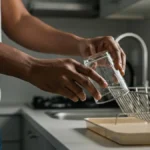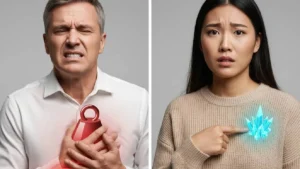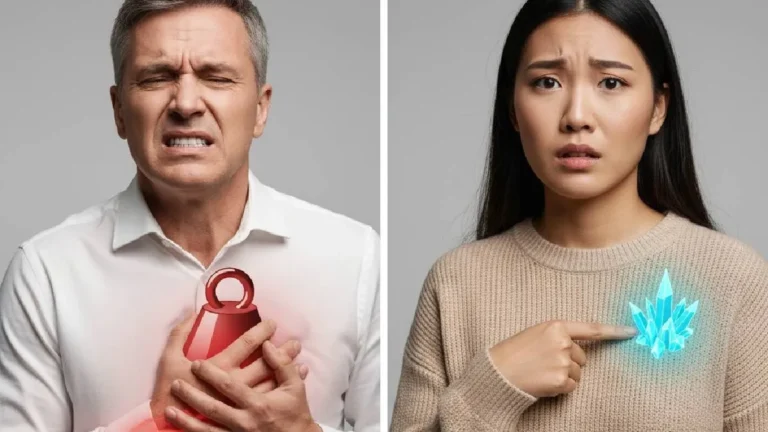Appendicitis is an acute inflammation of the appendix that typically causes abdominal pain, fever, or digestive upset. What are the symptoms? How is it treated? Here’s everything you need to know about it.
What is appendicitis and which side is it on?
It is the acute inflammation of the appendix, which is a natural diverticulum that extends from the cecum (between the small intestine and the right colon). The diagnosis of appendicitis requires rapid surgical resection because there is no parallel between the clinical signs and the extent of the anatomical lesions. The peak frequency is between 15 and 30 years of age, although appendicitis can occur at any age.
The different forms of appendicitis
These are:
- Acute appendicitis that occurs usually before the age of 30(especially between 10 and 14 years old, and 25 and 34 years old). The inflammation occurs suddenly;
- Chronic appendicitis is characterized by long-lasting pain. It remains rare, unlike the acute form.
What are the symptoms of appendicitis? How do you know if you have it?
Usually, the onset is sudden with the patient experiencing:
- A sharp pain located in the right iliac fossa (RIF), which is the area below and to the right of the navel. The pain is sharp, paroxysmal in the abdomen, radiating to the lower back and the root of the right thigh;
- Vomiting is subtle, food or bilious, and may be replaced by nausea;
- A fever is often moderate, around 38.5°C. The pulse is accelerated in relation to this hyperthermia.
- The tongue is covered with a whitish coating. The face is not tired.
- Constipation is sometimes associated.
- A change in general condition.
On examination, the abdomen is not distended and breathing is normal. Gentle and careful palpation reveals constant, sharp provoked pain at the MacBurney point (midpoint of an imaginary line from the navel to the anterior superior iliac spine). This provoked pain is accompanied by often subtle provoked guarding and cutaneous hyperesthesia. The pain becomes more acute if the patient is asked to raise his or her straight right leg.
Pelvic examinations (rectal examination and vaginal examination in women) reveal pain at the right apex of the pouch of Douglas. However, it is important to know that the diagnosis of appendicitis, made by the doctor, is not easy in practice because the different symptoms (or some of them) may or may not coexist.
Other forms of appendicitis
Unfortunately, clinical signs are far from always easy to recognize. Several atypical cases make diagnosis much more difficult:
- Appendicitis in young children and the elderly;
- Appendicitis in pregnant women;
- Appendicitis decapitated by blindly prescribed antibiotic treatment;
- Ectopic appendicitis (different):pelvic, subhepatic, retrocecal, mesocoeliac…
Causes: How does an appendicitis attack start?
The causes are not well understood. In most cases, pieces of hard stool, a foreign body, or even worms obstruct the inside of the appendix. This then causes inflammation and infection of the appendix. If left untreated, it perforates, leading to an abscess and peritonitis.
Peritonitis, a complication of appendicitis
Definition
It is the inflammation or infection of the peritoneum, following the rupture of the appendix wall. Initial peritonitis is sometimes the revealing form of perforated appendicitis. It can also be a complication of untreated appendicitis.
Symptoms
Purulent peritonitis has a very sudden onset marked by violent pain in the right iliac fossa (RIF) which quickly spreads to the entire abdomen.
- Vomiting is constant.
- The stopping of materials and gases is not clear.
- The fever is 40°C.
- The pulse is rapid in relation to the fever.
- The language is loaded, the face is anguished.
The symptoms are marked: the abdomen is immobile and not breathing. Palpation reveals a rigid, tonic, invincible, painful contraction of the abdominal muscles, which is predominant in IDF. The cutaneous hyperesthesia is clear: the patient refuses to allow the doctor to palpate his abdomen. The rectal examination is very painful.
Diagnosis
In the face of this peritonitis, the doctor must rule out perforation of a gastroduodenal ulcer: prehepatic dullness (dull sound on percussion under the liver) is preserved (unlike peritonitis due to perforation of an ulcer) and the plain abdominal X-ray (ASP) shows the absence of pneumoperitoneum.
Surgical treatment is urgent . During surgery, the surgeon finds pus in the peritoneum, false membranes, and an appendix perforation. The sample allows the germ to be identified and an antibiogram to be performed .
Diagnosis: additional examinations and analyses
The diagnosis of acute appendicitis is initially clinical but additional tests may be useful.
- A blood test, and in particular the blood count shows polymorphonuclear leukocytosis. sedimentation rate is accelerated;
- Imaging tests (scanner) can be useful in case of diagnostic difficulty but it is above all ultrasound which often gives typical images;
- There X-ray of the abdomen unprepared is normal half the time. In 10% of cases, it shows a stercolith (opaque calcification). It is mainly used to eliminate another surgical diagnosis.
Not to be confused with…
Acute appendicitis must be distinguished from pathologies whose clinical picture may be similar:
- Pneumonia from the right base (chest x-ray) ;
- Renal colic;
- Pyelonephritis (kidney infection), which is sought by the ultrasound;
- Viral hepatitis (transaminase dosage)…
Mesenteric lymphadenopathy is only discovered during surgery. Often, the surgeon must decide to operate because angina or nasopharyngitis are followed by abdominal symptoms. Surgery reveals a healthy appendix, mesenteric lymphadenopathy (nodes), and thickening of the cecum and terminal ileum walls.
Among genital disorders, ectopic pregnancy and torsion of an ovarian cyst are operative findings.
Salpingitis may be confused with pelvic appendicitis. Ultrasound is helpful . Laparoscopy is sometimes performed.
Among the surgical conditions, infection of a Meckel’s diverticulum , Crohn’s disease , acute cholecystitis , a perforated ulcer or acute pancreatitis will justify an appropriate surgical approach.
Treatments for appendicitis
Do we still operate on appendicitis?
Treatment for appendicitis is surgical. It involves removing the infected appendix.
Classic appendectomy
Appendectomy is performed under general anesthesia with intubation. The usual incision is made on the right flank and is only a few centimeters long. Any difficulty encountered by the surgeon leads to enlarging the incision.
The surgery involves removing the diseased appendix. The average time is 30 minutes.
Postoperatively, the IV is removed after the 6th hour. The pain subsides with sedatives. Nausea, sometimes with vomiting, bothers the patient for one or two days. The next day, the patient gets up. Light diet is resumed early. Antibiotics and anticoagulants are not used routinely.
The emission of gas marks the beginning of healing around the 48th hour, discharge is possible after a few days. The stitches are removed on the 7th day. Work stoppage is 2 to 3 weeks.
The decision to operate is made at the slightest doubt in France, but the number of appendectomies is steadily decreasing, a sign of improved diagnostics. The risks of unnecessary appendectomy are minimal. The risk to life is 40 times lower than that of delayed treatment leading to perforation and peritonitis.
Appendectomy under laparoscopy
Appendectomy can also be performed laparoscopically. Laparoscopy often provides the key to diagnosis in these right iliac fossa pains and allows for treatment at the same time.
The procedure is performed under general anesthesia. The abdomen is distended by gas insufflation, then the laparoscope is inserted through the umbilical route into the peritoneal cavity. It is a tube made of optical fibers, which will allow a video camera to capture images of the interior of the abdomen. The tools are inserted through tiny puncture points. The appendix is then searched for, freed, and observed, and the extraction route is then chosen if necessary.
The post-operative course is very simple: gas and bowel movements resume within 24 hours, no scarring or pain, the patient is discharged on the 3rd day, and activity resumes 2 to 4 days later.






















+ There are no comments
Add yours